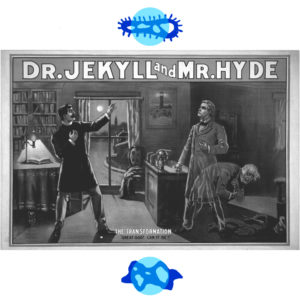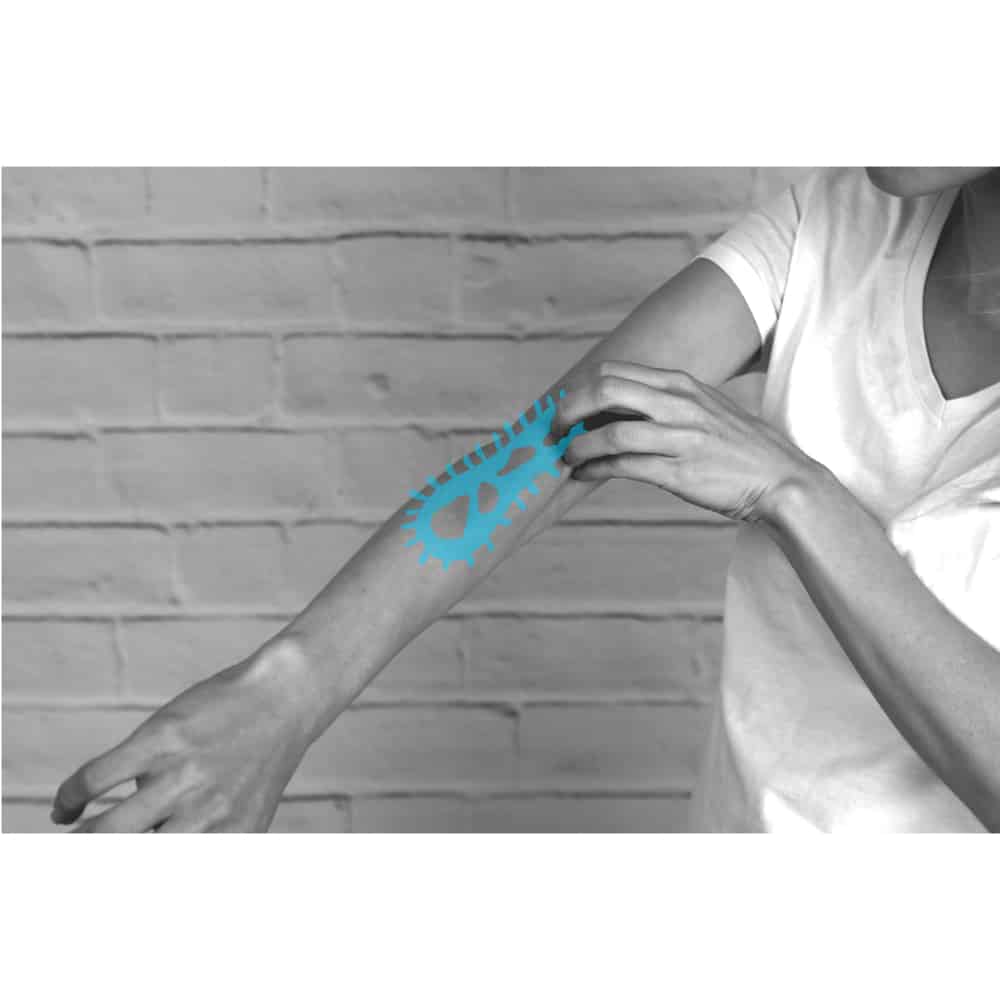Shortly after the Scottish surgeon Sir Alexander Ogston discovered Staphylococci sp. in 1882, fellow Scot, Robert Louis Stevenson published, The Strange Case of Dr. Jekyll and Mr. Hyde.[1] The famous gothic novel explores the two alter egos of the main character, both exhibiting wildly contradicting behaviors. In the book, the well-respected and ‘good’ Dr. Henry Jekyll drinks a special potion which brings out his alternate ‘evil’ personality, Mr. Edward Hyde.
“Our skin microbes can take on dual personalities”
Like Jekyll and Hyde, our skin microbes can also take on dual personalities. The previously used binary terms, ‘good’ and ‘bad’, are now increasingly recognized as part of a broader description for the complex behavior of bacteria depending on a number of factors. For example, a ‘good’ skin bug, like S. epidermidis, can also cause life-threatening infections. Conversely, the ‘bad’ bug S. aureus, colonizes 30% of the US population without causing any issues. The transformation of a single strain of bacteria from commensal to pathogen has been an area of intense research, especially when it comes to nosocomial (hospital born) infections with antibiotic resistant organisms such as MRSA.[2] Recent research suggests that this Jekyll and Hyde transformation also plays a role in the etiology of common chronic skin inflammatory conditions like atopic dermatitis and acne. Most exciting is that the biochemistry of the transformation offers new targeted therapeutic approaches for prevention and treatment of these common skin problems.

‘Jekyll and Hyde’ and the link with atopic dermatitis
The ‘Jekyll and Hyde’ skin microbiome is best exemplified by S. aureus in atopic dermatitis (AD) – the most common form of eczema. AD is a chronic relapsing pruritic (itching) inflammatory skin disease that affects up to 30% of children and 10% of adults in developed countries. It was over 40 years ago that Leyden, Marples and Kligman used traditional culture methods to discover that S. aureus was the predominant organism in AD lesions, a seminal finding in skin microbiome history.
Flash forward to today’s advancements in DNA sequencing, bioinformatics and clinical tools to study the skin microbiome and Leyden’s original findings make complete sense. It now appears that S. aureus is much more than just associated with AD; scientists are now pointing their finger directly at S. aureus as the central player in disease etiology.[3] For example, we know that the onset of the disease flare is directly preceded by an increased abundance of S. aureus and a concomitant decrease in skin microbiome diversity. Flare remission is preceded by a return to normal levels of S. aureus abundance and skin microbiome diversity. Moreover, S. aureus goes through some amazing biochemical transformations from good to evil during disease flares; it is our prototypical ‘Jekyll and Hyde’ bacterium.
The real offender: the biofilm
If you Google ‘images of bacteria’, you will find beautiful pictures of bacteria swimming around, free-floating in a planktonic life stage. However, bacteria are quite social organisms. They generally like to get together with their friends and build cozy little homes in organized structures called biofilms. Biofilms are arguably the most successful and prolific life form on the planet. Even the plaque that builds up on your teeth is the result of a biofilm. Biofilms are notorious for their role in serious infection, especially infection of indwelling medical devices, lung infections, sinusitis and several other diseases.
“Bacteria are quite social organisms”
To make matters worse, the bacteria in biofilms are very clever and have figured out how to shield themselves from the host immune system and therefore can be a thousand times more resistant to antibiotics compared to their planktonic counterparts. Both S. epidermidis and S. aureus have capacity to form biofilms with strain level variability. The capacity of a given strain of S. aureus to form a biofilm in skin sweat ducts is directly correlated with AD severity. S. aureus biofilm formation may be the Mr. Hyde virulence factor in AD.
Understanding the transformation from Jekyll to Hyde
Exactly what causes the transformation is multifactorial; strain, host immunity, stratum corneum barrier function, environmental stress and other factors are all at play. Transformation re quires cell-to-cell communication through quorum sensing – bacteria’s equivalent to Facebook communication mechanism. The gene that drives quorum sensing for S. aureus is called agr. This stands for Accessory Gene Regulator (if I had discovered this fascinating gene, I would have given it a much catchier name like mhg for the Mr. Hyde Gene!). As all genes code for proteins, agr codes for several proteins, one of which is a short peptide called auto-inducing peptide (AIP). AIP is secreted from the bacterial cell and can induce synthesis of itself in a positive feedback amplification mechanism. AIP is the bacterial equivalent of Dr. Jekyll’s potion. AIP also promotes the virulence of S. aureus’ friends through upregulation of agr-coded toxins which cause skin inflammation and itching. The more AIP, the more Likes on Mr. Hyde’s Facebook page. This is truly bacteria going viral!
quires cell-to-cell communication through quorum sensing – bacteria’s equivalent to Facebook communication mechanism. The gene that drives quorum sensing for S. aureus is called agr. This stands for Accessory Gene Regulator (if I had discovered this fascinating gene, I would have given it a much catchier name like mhg for the Mr. Hyde Gene!). As all genes code for proteins, agr codes for several proteins, one of which is a short peptide called auto-inducing peptide (AIP). AIP is secreted from the bacterial cell and can induce synthesis of itself in a positive feedback amplification mechanism. AIP is the bacterial equivalent of Dr. Jekyll’s potion. AIP also promotes the virulence of S. aureus’ friends through upregulation of agr-coded toxins which cause skin inflammation and itching. The more AIP, the more Likes on Mr. Hyde’s Facebook page. This is truly bacteria going viral!
What does this mean for treatment of skin conditions?
So, we now have a much better understanding of how the Jekyll-Hyde transformation causes chronic skin inflammation at the molecular level. With this understanding, we can rationally design agents that target this mechanism. We call this therapeutic approach ‘quorum sensing inhibition’ or QSI. QSI targets bacterial communication and the virulence factors causing the skin inflammation. It does not target bacterial viability, abundance, composition or diversity. As such, QSI is neither probiotic, prebiotic, postbiotic nor antibiotic. It effectively targets the source of the inflammation, rather than the downstream effects of skin inflammation.
In summary, bacteria are not ‘good’ or ‘bad’. They are just bacteria. But they can have a ‘Jekyll and Hyde’ dual personality. Most of the time, they behave and there is a healthy and harmonious balance between our skin and the microbes that live on it. However, environmental stresses and other factors can cause our skin microbes to start behaving badly, resulting in inflammation, itching, scaling and other signs of imbalance between our skin and the microbes. QSI targets the molecular mechanism of the ‘Jekyll to Hyde’ transformation for healthy, beautiful skin.
Want to read more? See our Instagram page here.
[1] See Bacterial Basics: Staphylococci by Markus Egert (https://thesecretlifeofskin.com/the-staphylococci/)
[2] MRSA: Methicillin-resistant Staphylococcus aureus
[3] Filaggrin (FLG) mutations were once thought to cause AD. However, most AD patients do not harbor FLG mutations and 60% of mutation carriers do not present with AD symptoms. Thus, FLG mutations are neither necessary nor sufficient to cause AD.
